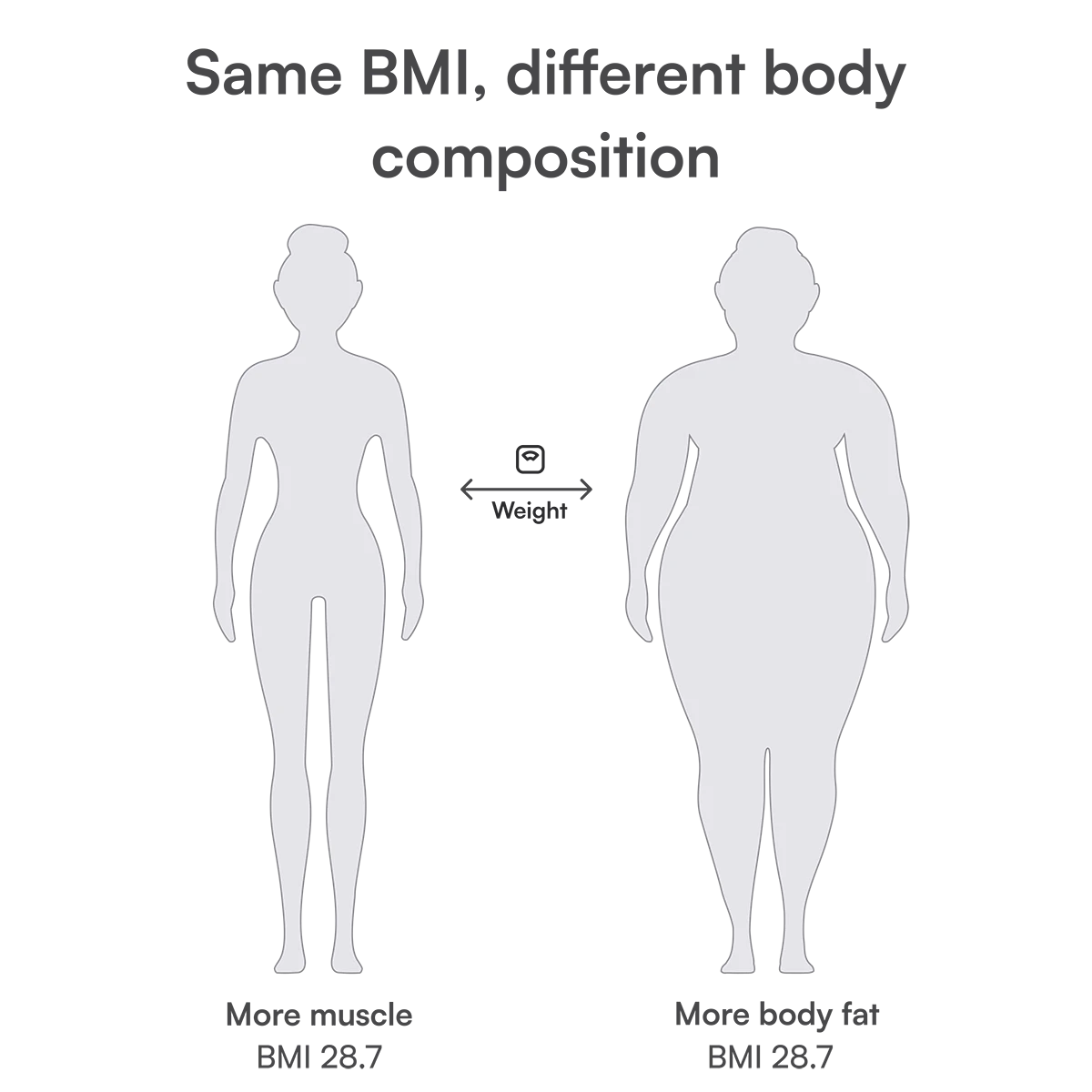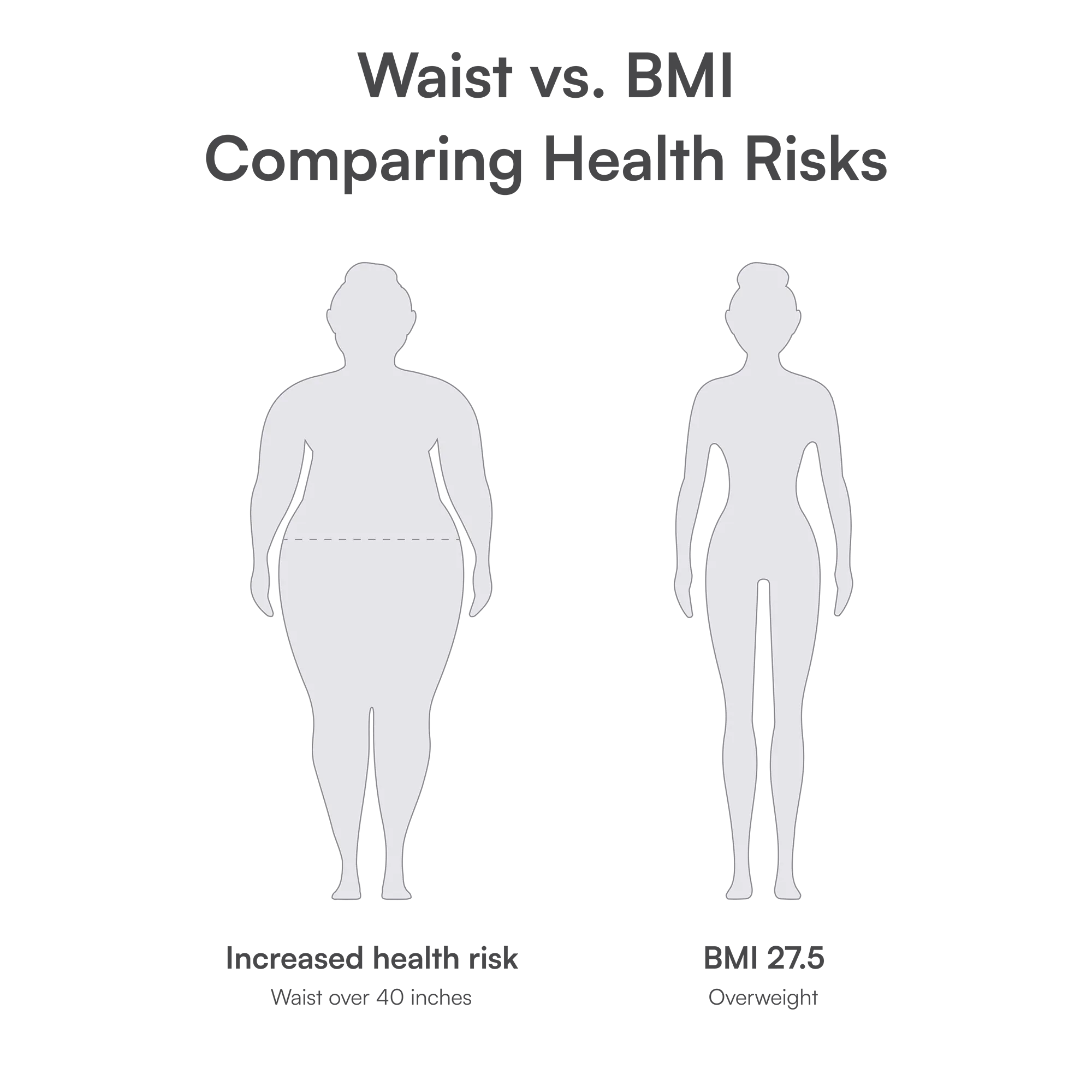Eden’s BMI Calculator: Your Guide to Body Mass Index on Your Weight Loss Journey
If you’re on a weight loss journey, you’ve probably heard about Body Mass Index (BMI). It’s a simple measure that can help you understand where you stand in terms of weight relative to your height. In this guide, we’ll explain what BMI is, how it’s calculated, and how to interpret your BMI category – whether that’s underweight, normal, overweight, or obese. We’ll also discuss the benefits and limitations of BMI as a health metric, so you know exactly what this number can (and can’t) tell you. Importantly, we’ll introduce Eden’s free BMI Calculator, a handy tool you can use to check your BMI anytime. This calculator is provided by Eden as a free resource to support your wellness journey, but remember: it’s an educational tool and not a substitute for professional medical advice. Everyone’s health journey is unique, and BMI is just one starting point. Let’s dive in to learn how to use it wisely.
This calorie calculator is intended for informational and educational purposes only. The results are an estimate and are not intended to be a substitute for professional medical advice, diagnosis, or treatment.
What Is BMI?
BMI stands for Body Mass Index – a number that is commonly used to categorize a person’s body weight relative to their height. In simple terms, BMI offers a quick estimate of body fat for most adults. Health professionals worldwide use BMI as a screening tool to identify whether an individual falls into a healthy weight range or if they might be underweight or overweight. The National Institutes of Health (NIH) and the World Health Organization (WHO), for example, use BMI thresholds to define categories like underweight, normal weight, overweight, and obesity.
It’s important to understand that BMI is not measuring fat directly – it’s derived from your height and weight. However, it correlates fairly well with more direct measures of body fat for most people, making it a convenient way to flag potential health concerns. A higher BMI often implies higher body fat and has been associated with greater risks of health issues such as heart disease, high blood pressure, type 2 diabetes, gallstones, breathing problems, and certain cancers. Conversely, a very low BMI could indicate insufficient body fat or muscle mass, which might be linked to malnutrition or other health problems.
In summary, BMI is a useful starting point for assessing weight status: it gives you a general idea of whether you’re in a healthy range. But it’s not a complete diagnosis. Think of it as a signal – if your BMI is too high or too low, it signals that you might want to dig deeper into your overall health, ideally with a healthcare provider’s guidance.
How Is BMI Calculated?
Calculating BMI is straightforward math. The formula uses your weight and height:
- In metric units, BMI is calculated as your weight in kilograms divided by the square of your height in meters. In formula terms:
BMI = weight (kg) / [height (m)]². - In U.S. customary units (pounds and inches), a conversion factor is used. The formula becomes:
BMI = (weight (lb) / [height (in)]²) * 703.

Don’t worry – you don’t need to manually crunch these numbers unless you want to. Eden’s free BMI Calculator will do the math for you instantly. You simply enter your height and weight (in either metric or imperial units), and the tool computes your BMI number and category on the spot. This makes it easy to check your BMI without any hassle or risk of arithmetic errors.
For example, suppose someone is 5’6” (167.6 cm) tall and weighs 140 pounds (63.5 kg). The calculator will output a BMI around 22.5, which falls right in the middle of the “normal/healthy weight” range. If that same person weighed 180 lbs (81.6 kg) at the same height, their BMI would be about 29, nearing the upper end of the “overweight” category. As you can see, BMI provides a quick way to gauge how your weight compares to a healthy range for your height.
A note on units: The BMI formula works best in metric. If you use pounds and inches, the calculator’s use of the factor 703 adjusts for those units. Eden’s calculator accepts both systems, so use whichever you’re comfortable with – the result will be the same category either way.
BMI Categories and What They Mean
Once you have your BMI value, the next step is understanding what it means. BMI falls into several standard categories that indicate broad weight status. According to the U.S. Centers for Disease Control and Prevention (CDC) and other health authorities, adult BMI is interpreted as follows:
- Underweight: BMI below 18.5.
- Normal (Healthy) Weight: BMI 18.5 to 24.9.
- Overweight: BMI 25.0 to 29.9.
- Obese: BMI 30.0 and above.

Most people will fall into one of those four main categories. (Obesity is sometimes further classified into subclasses – e.g. Class 1 obesity for BMI 30–34.9, Class 2 for 35–39.9, and Class 3 for 40+ – to denote increasing severity. But generally, any BMI 30 or above is considered obese.) Each category comes with some general health interpretations:
- Underweight: If your BMI is under 18.5, it means your weight is low compared to your height. This could simply be your natural build, but it might also signal that you’re not getting enough nutrition or that an illness is affecting your weight. Being underweight can carry health risks like weakened immunity, nutrient deficiencies, or bone loss (osteoporosis), especially for women. If you find yourself in this category, consider talking with a healthcare provider. They can help determine if you might need to gain weight for your health and how to do so safely.
- Normal Weight: A BMI between 18.5 and 24.9 is considered a healthy weight for most adults. Congratulations – this range is associated with the lowest risk for weight-related health problems. Staying in this range usually means you’re balancing your intake and activity well. Keep up those healthy habits! However, “normal” doesn’t automatically mean “optimal” for every individual. It’s still important to maintain a balanced diet and active lifestyle to stay healthy.
- Overweight: A BMI from 25.0 to 29.9 falls in the overweight range. This suggests you’re carrying more weight than is generally considered healthy for your height. Many people in this category are still perfectly healthy, but statistically, being overweight can increase your risk of health issues over time (like heart disease, high blood pressure, or type 2 diabetes) if the trend continues. It’s often a good idea to evaluate your diet and activity levels if you’re in this range. Even modest weight loss – as little as 5-10% of your body weight – can have health benefits if you’re overweight. For instance, if you weigh 180 lbs, losing 9–18 lbs (4–8 kg) could improve blood pressure, blood sugar, or cholesterol levels. If you’re overweight, consider this BMI a friendly nudge to talk with a healthcare provider about your wellness strategies (not a reason to panic or feel bad about yourself).
- Obese: A BMI of 30 or above is classified as obese. This indicates a significant amount of excess weight relative to height. Obesity is associated with a higher risk of a number of serious health conditions – for example, adults with obesity have a greater chance of developing heart disease, type 2 diabetes, certain cancers, sleep apnea, and other issues. The higher the BMI is above 30, generally the higher the health risk. The good news is that, like the overweight category, losing even a moderate amount of weight can yield health benefits. Experts often recommend that people with obesity pursue weight loss to improve their health, usually through a combination of nutrition, exercise, and sometimes medical interventions. It’s very important to approach this in a sustainable and supportive way – crash diets are not the answer. If your BMI is in the obese range, consider reaching out to a healthcare professional for personalized guidance. They can help tailor a plan that takes into account your overall health, lifestyle, and any underlying factors.
One important caveat: BMI categories are one-size-fits-all thresholds that don’t account for individual differences. They don’t distinguish between men and women, nor between people of different ethnic backgrounds or ages – yet body composition can vary across these groups. For example, some Asian populations may experience weight-related health risks at lower BMI values than the standard cutoffs, and older adults might have more body fat at a “normal” BMI due to muscle loss. But to keep things straightforward, the guidelines above apply broadly to adults 20 years and older, regardless of sex or age. Always interpret your BMI in context of your personal health situation.
Finally, remember that BMI is a starting point. It’s not destiny. If your BMI isn’t where you want it to be, don’t be discouraged – it’s something you can change over time with healthy lifestyle adjustments. And if your BMI is in a good range, that’s great – but still maintain those healthy habits to keep it there.
Benefits of Using BMI as a Health Metric
Why do doctors and health experts use BMI at all? The main appeal of BMI is that it’s simple, quick, and cost-free. All you need are two numbers – your height and weight – which you likely already know or can measure easily. From those, BMI gives a single value that has been widely studied in relation to health outcomes.
Some key benefits and strengths of BMI include:
- Easy to Use: Unlike many medical tests, calculating BMI doesn’t require any fancy equipment or lab tests. Anyone can figure out their BMI in seconds with a basic calculator (or instantly with Eden’s online calculator). This makes it very accessible as a first look at someone’s weight status.
- Standardized Categories: BMI provides clear-cut categories (underweight, healthy, overweight, obese) that are used internationally. These standard definitions mean that both you and your healthcare provider can be on the same page when discussing your weight. For instance, a BMI of 32 will be categorized as “obesity” in any doctor’s office, which signals the need to consider weight management strategies. The consistency of BMI categories, as set by bodies like the NIH and WHO, has largely replaced older height-weight charts.
- Indicator of Health Risk: BMI can serve as a general indicator of potential health risks. Research and public health statistics have shown that as BMI increases, so does the risk for various diseases. For example, a higher BMI often correlates with higher chances of developing cardiovascular disease or diabetes. Likewise, a very low BMI might be linked to malnutrition or bone density loss. Because of these correlations, BMI is a convenient way for healthcare providers to identify who might benefit from weight-related guidance. The CDC describes BMI as “a good gauge of your risk for diseases that can occur with more body fat. The higher your BMI, the higher your risk for certain diseases such as heart disease, high blood pressure, type 2 diabetes, gallstones, breathing problems, and certain cancers.” In population studies, BMI is a key metric for tracking obesity rates and related health outcomes on a large scale.
- Starting Point for Discussion: For individuals, knowing your BMI can be a useful starting point for conversation about weight and health. It can validate concerns you might have (“I feel like I’ve gained weight, and my BMI moved from normal to overweight – what should I do?”) or provide reassurance (“My BMI is in the normal range, so my current routine is working well.”). Many doctors will calculate BMI as part of routine check-ups. If it’s high or low, it opens up a dialogue about diet, exercise, and other factors. Essentially, BMI can prompt timely health interventions when needed.
In short, BMI is popular in healthcare because it’s an efficient screening tool. It gives a useful rough picture of body composition for most people without expensive tests. Think of BMI as a flag: green (normal) generally means all clear, yellow (overweight) may mean caution, and red (obese or underweight) means it’s worth taking action or investigating further. It’s not the whole picture (as we’ll discuss next), but it’s definitely a helpful piece of the puzzle.
Limitations of BMI
While BMI is handy, it’s far from perfect. Relying only on BMI can sometimes be misleading. Here are some of the known limitations and why you shouldn’t consider BMI the final word on your health:

- Not a Direct Measure of Body Fat: BMI doesn’t actually measure the percentage of fat in your body – it only uses weight and height. Weight includes not just fat, but also muscle, bones, organs, water, etc. Two people with the same BMI could have very different body compositions. For example, imagine an athlete who is 5’10” and 200 lbs of mostly muscle, and a sedentary person who is also 5’10” and 200 lbs with higher body fat. Both would have the same BMI (~28.7, overweight), but the athlete might have low body fat and be very fit, whereas the sedentary individual has higher fat and may indeed have health risks. BMI can overestimate body fat in people with high muscle mass (like bodybuilders or some male athletes). In these cases, a high BMI might flag “overweight” or “obesity” even though the person’s body fat percentage is low and their health is excellent.
- May Underestimate Fat in Some Cases: Conversely, BMI can underestimate body fat for certain people. Older adults, for instance, often lose muscle mass as they age. They might have a normal BMI but a higher body fat percentage than a younger person with the same BMI. Similarly, someone who has lost muscle (perhaps due to a medical condition or a very sedentary lifestyle) could have a “healthy” BMI yet still carry unhealthy amounts of fat internally. In women, who generally have more body fat than men at the same BMI, this could mean a woman at the higher end of “normal BMI” might still want to be mindful of body composition. In short, BMI doesn’t distinguish between weight from muscle and weight from fat. So context matters.
- No Insight on Fat Distribution: BMI tells you nothing about where your body fat is distributed. This is important because fat in the abdominal area (visceral fat around organs) is more strongly linked to health risks like heart disease and diabetes than fat in other areas (like hips or limbs). You could have a normal BMI but carry a lot of weight around your waist, which studies suggest raises health risks more than weight around the thighs or hips. For a fuller picture, measures like waist circumference are helpful. For example, the NIH notes that if your waist circumference is over 35 inches for women or 40 inches for men, it signals higher risk, even if BMI isn’t very high. BMI alone wouldn’t catch that distinction. So, one person with BMI 27 who carries weight mostly in the belly might be at more risk than another person with BMI 27 who carries it more evenly or in the lower body. BMI doesn’t capture these nuances.
- Same Cutoffs for All Adults: The BMI categories are the same for men and women and do not adjust for ethnicity or age. But ideal body composition can differ. Women naturally have a higher body fat percentage than men, and older people tend to have more fat than younger adults for a given BMI. Additionally, as mentioned, some ethnic groups might experience metabolic issues at lower BMIs. For instance, health experts have observed that Asian populations may have a higher risk of diabetes at BMIs that would still be considered “normal” by standard definitions. Meanwhile, some individuals of Polynesian descent might be healthy at BMIs that edge into the “overweight” range due to higher lean body mass. The one-size-fits-all nature of BMI ignores these differences. It doesn’t mean BMI is useless – it just means some people will be exceptions to the rule.
- Not a Holistic Health Measure: Perhaps most importantly, BMI looks at just one aspect: weight relative to height. It doesn’t reflect other vital components of health – such as nutrition quality, fitness level, blood pressure, cholesterol, blood sugar, mental health, etc. A person with a “normal” BMI could have poor nutrition and be physically unfit. Another person with a high BMI might have excellent cardiovascular fitness and normal metabolic numbers (sometimes called “metabolically healthy obesity” in research). So, BMI should never be the only assessment of your health. It’s a starting point that should be followed up with a more thorough evaluation if necessary.

In summary, BMI has limitations and should be interpreted with care. Medical experts explicitly state that “BMI is insufficient as the sole means of classifying a person’s health”, especially in certain populations. For individuals like elite athletes or bodybuilders, an elevated BMI may not accurately reflect poor health at all. On the other hand, for older adults or those with low muscle mass, a “normal” BMI might mask underlying issues. Always consider BMI alongside other measurements and personal factors. If your BMI result seems surprising or confusing, that’s a good opportunity to dig deeper – perhaps by measuring body fat percentage, checking metabolic health markers, or consulting a healthcare provider for a comprehensive evaluation.
BMI Is One Tool Among Many
Given the limitations above, it’s clear that BMI is just one tool in understanding your body composition and overall wellness. It’s useful, but it’s not the whole story. So what other metrics or factors should you consider on your health journey?
- Body Fat Percentage: This is a measure of how much of your body weight comes from fat versus lean tissue (muscles, bones, organs, water). Two people with the same BMI can have different body fat percentages. Methods to measure body fat include skinfold calipers, bioelectrical impedance scales, DEXA scans, and others. While some of these methods require special equipment, even a simple body fat scale at home can give additional insight. For instance, an athlete might have a high BMI but a low body fat percentage, indicating that most of their weight is muscle (and thus their high BMI is not a health concern). On the contrary, someone could be in the normal BMI range but have a high body fat percentage (sometimes called “skinny fat”), which might warrant improving their diet or exercise routine. Tracking body fat percentage over time can complement BMI by showing whether weight changes are due to fat loss/gain or muscle changes.
- Waist Circumference and Waist-to-Hip Ratio: As mentioned, where you carry fat matters. Measuring your waist (and maybe your hips) can tell you if you have more of an “apple” shape, which is linked to higher health risks, or a “pear” shape. Health authorities often use waist circumference thresholds (35 inches for women, 40 inches for men) as a risk indicator. If your BMI is high and your waist measurement is also above these cutoffs, that combination is a stronger signal to take action than BMI alone. Conversely, if you have an overweight BMI but a relatively small waist and otherwise good health indicators, your doctor might be less concerned. In any case, incorporating waist measurements gives a more complete picture of your metabolic health.
- Physical Fitness and Strength: BMI says nothing about how fit or strong you are. Cardiovascular fitness (heart and lung health) and muscular strength/endurance are huge components of wellness. Someone with a higher BMI who exercises regularly might have better heart health and endurance than someone with a normal BMI who is sedentary. Pay attention to non-scale victories: Can you walk or jog longer than you could before? Are you getting stronger or more flexible? These improvements might not show up in your BMI, but they are meaningful health gains.
- Nutrition and Diet Quality: All calories are not equal when it comes to health. Regardless of BMI, focus on fueling your body with nutritious foods – vegetables, fruits, lean proteins, whole grains, healthy fats. It’s possible to have a normal BMI but eat a poor diet (leading to issues like high cholesterol or vitamin deficiencies). Conversely, some people with a high BMI might still have strong nutritional habits – though weight loss might be easier with some dietary adjustments. Use BMI as a cue to evaluate what you eat. Are you getting a balanced diet? Are you consuming too many sugary or processed foods? A healthier diet can improve your health metrics even before significant BMI changes occur.
- Other Health Markers: Numbers like blood pressure, cholesterol levels, blood sugar (glucose), and triglycerides are critical in understanding health, particularly related to weight. You can be in the overweight BMI category but have normal blood pressure, normal blood sugar, etc., which is a good sign. Or you could be in the normal BMI range but have, say, high cholesterol that needs attention. BMI doesn’t measure any of these. That’s why doctors consider BMI alongside these other factors. If your BMI is high, checking these markers can determine if weight is already affecting your health. If they’re normal, you might be what’s called “metabolically healthy overweight,” but it’s still wise to work on weight to prevent future problems. If they’re abnormal, it adds urgency to weight management efforts.
- Mental and Emotional Wellbeing: Numbers like BMI are purely physical metrics, but your wellbeing also encompasses mental health, stress levels, and body image. Sometimes, an intense focus on BMI or weight can be stressful or counterproductive. It’s important to use tools like the BMI calculator as helpful information – not as a source of shame or anxiety. Everyone’s journey is personal. Factors like stress, sleep, and mental health can impact your weight and vice versa. Ensure you approach BMI and weight changes with a healthy mindset, possibly with support from friends, family, or professionals.
In essence, use BMI as a piece of the puzzle, not the whole picture. The CDC itself advises that “BMI is a screening measure” and should be considered with other factors when assessing an individual’s health. If you have questions or concerns about what your BMI means for you, it’s wise to discuss them with a healthcare provider who can interpret your BMI in context. They might say, “Yes, your BMI is a bit high, but let’s also look at your lifestyle and other health markers to decide what’s best to do,” or, “Your BMI is low – let’s check if everything is okay nutritionally.” By looking at the full picture, you’ll get a more accurate assessment of your wellness than any single number can provide.
BMI and GLP-1 Weight Loss Medications
If you’re using (or considering) GLP-1 medications as part of your weight loss journey, you might be wondering how BMI factors into the equation. GLP-1 receptor agonists – such as semaglutide (brand names like Ozempic® or Wegovy®) or liraglutide (Saxenda®) – are a newer class of medications that may help with weight loss by reducing appetite and improving blood sugar control. They’ve garnered a lot of attention for their effectiveness. Here’s how BMI comes into play with these treatments:
- Eligibility for Treatment: BMI is often a key criterion for whether a person qualifies for prescription weight loss medications, including GLP-1 agonists. Doctors and guidelines typically reserve these medications for individuals who are classified as obese (BMI of 30 or above) or overweight with serious health complications (BMI of at least 27 plus conditions like diabetes or hypertension). In fact, when the FDA first approved a GLP-1 drug for weight loss in 2014, it was indicated for patients with BMI ≥ 30, or ≥ 27 with a weight-related comorbidity. What this means: if you’re discussing weight loss options with your healthcare provider, knowing your BMI will help determine if a GLP-1 medication is an option. For example, if your BMI is 35, you clearly fall into the potential candidacy range for these drugs; if your BMI is 24, medication likely wouldn’t be prescribed, and lifestyle changes would be the focus instead. Keep in mind, only a qualified provider can evaluate your individual case – BMI alone doesn’t guarantee any specific treatment, but it’s a big part of the decision framework.
- Tracking Progress: If you and your doctor do decide on a GLP-1 medication or another weight loss therapy, BMI can serve as one way to track your progress over time. These medications often result in significant weight loss for many users, which will be reflected in a lowering of BMI. For example, if you start with a BMI of 34 and after several months on a GLP-1 you lose 20% of your body weight, your BMI might drop into the mid-20s (moving from “obese” to “overweight” or even “normal”). That’s an encouraging change! Providers might set target BMI goals or weight loss percentages to achieve with the help of the medication. However, it’s important to focus on overall health changes, not just the BMI. Pay attention to improvements in blood sugar (if you’re diabetic or prediabetic), blood pressure, energy levels, and how you feel day-to-day. Those are just as important as the number on the scale.
- Discussion with Your Healthcare Provider: BMI should foster conversation with your healthcare provider when you’re on a GLP-1. For instance, you might ask: “My BMI is now 25 after losing weight – should I continue the medication or consider stopping?” or “What BMI should I aim for to improve my health markers?” Doctors will use BMI as one reference point, but they’ll also consider how you’re tolerating the medication, any side effects, and other health improvements. Some patients might achieve a healthier BMI and then work on maintaining that weight through lifestyle, while others might need to stay on the medication longer term under medical advice. Always follow your provider’s guidance – the BMI calculator is there to inform you, but the treatment decisions are individualized.
- BMI Isn’t Everything (Even in GLP-1 Therapy): It’s worth noting that while GLP-1 drugs can be very effective at reducing weight (and thus BMI), there’s more to the story. Studies have found that weight loss from these medications includes loss of fat (which is good) but can also include some loss of lean muscle mass. That means if you’re on a GLP-1, you should still engage in healthy eating with adequate protein and perhaps resistance exercises to help preserve muscle. Your BMI might drop, but you want to make sure you’re losing fat, not muscle. This again highlights why BMI is a starting point – you might reach a “normal” BMI on the scale, but maintaining muscle and strength is vital for long-term health. Additionally, mindset and habits are key: some people on GLP-1s become very “hyper-focused on weight loss as the ultimate measure of success,” neglecting other aspects of health. Try not to fall into that trap. Celebrate improvements like better mobility, improved lab results, or increased confidence, not just the BMI number.
In summary, for GLP-1 users, BMI is part of the journey but not the whole journey. It likely played a role in starting the therapy (due to medical guidelines around BMI), and it will be one of the metrics used to gauge progress. Eden’s free BMI Calculator can be a convenient way to keep an eye on this number at home and even share it with your provider during check-ins. Just remember that any medication is one tool among many: you’ll get the best results when combining it with lifestyle changes and using BMI alongside other health indicators to monitor your success.
Using Eden’s Free BMI Calculator (It’s Quick & Easy)
Throughout this article, we’ve mentioned Eden’s free BMI Calculator – so how do you use it, and why might you choose Eden’s tool? Here’s a quick rundown:
Accessibility: Eden’s BMI Calculator is available online for free. There’s no cost, no sign-up required, and you can use it as often as you like. Whether you’re at home on your laptop or on your phone after a doctor’s appointment, you can quickly navigate to the calculator and get your BMI result within seconds. This makes it convenient to check your BMI periodically as you progress in your weight loss journey.
User-Friendly Design: The calculator is straightforward by design. You’ll input your height (in feet and inches or in centimeters) and your weight (in pounds or kilograms). With one click, it will instantly compute your BMI. The result will typically display your BMI number to one decimal place and indicate which category that falls into (for example, “22.5 – Normal Weight”). This immediate feedback helps you understand your status right away, without needing to interpret complicated charts. Eden’s tool takes the guesswork out of the calculation.
Understanding Your Results: Along with giving you the number, Eden’s BMI Calculator interface provides some context for what your result means. It might highlight the category (underweight, normal, etc.) and could offer a brief note of guidance. For instance, if your BMI is in the overweight range, the tool might remind you that this is above the healthy range and encourage consideration of healthy diet and exercise – without alarmism, just factual context. Likewise, if you’re in the normal range, it may congratulate you and encourage maintaining your lifestyle. The goal is to make sure you not only see the number, but also know how to interpret it in broad terms.
Tracking and Privacy: If you plan to track your BMI over time, you can of course use the calculator repeatedly and note down your results (for example, keep a simple log: “January – BMI 31, March – BMI 29” etc. to see the trend). The Eden BMI Calculator itself does not store your personal data or history – each calculation is a standalone event, so your privacy is maintained. This means you’ll need to record the numbers yourself if you want a history, but it also means you can use the tool anonymously and confidently. It’s simply there to serve you with information.
Not Medical Advice: We want to reiterate an important point – while the calculator provides health-related information, it is not providing medical advice or diagnosis. The tool will not tell you something like “You should take X medication” or “You have Y disease” – because it can’t and shouldn’t. It gives a BMI result and general category info. Determining what to do with that information is up to you and ideally done in consultation with a medical professional if your BMI is a concern. As Hims & Hers (the platform Eden is part of) state on their own BMI tool, “The BMI calculator does not determine eligibility for any weight loss medications or treatments… Consultation with a healthcare provider is necessary for personalized advice.” In the same spirit, Eden’s free BMI Calculator is here to educate and empower you with a quick metric – not to replace professional guidance. Always use it as a helpful reference, and speak to a doctor or nutritionist for an in-depth assessment or before making major changes to your health regimen.
In using Eden’s BMI Calculator, you’ll find that it’s a supportive starting point. Many people appreciate having a clear number to start with, especially when embarking on weight loss. It can make goals feel more concrete (e.g., “My BMI is 28, I’d like to get it into the low 24s which is a healthy range for me”). And because it’s free, you can check in as often as you like without any barriers. Just keep in mind that, as we’ve detailed, BMI is one factor – use the tool to stay informed, but always consider the bigger picture of your health.
Conclusion: BMI Is Just a Starting Point – Your Journey Is Individual
Your weight loss or wellness journey is uniquely yours. BMI is a useful starting point, but it’s not the final verdict on your health or success. Think of BMI as a compass: it can tell you the general direction you’re headed (toward underweight, healthy, or overweight ranges), but it doesn’t define all the terrain on your path. Many factors – genetics, activity level, nutrition, mental health, medical conditions – influence your well-being.
If your BMI is higher than you’d like, use it as motivation, not as a judgment. It’s one piece of feedback. Maybe it’s telling you to be more mindful of portion sizes, or to incorporate more movement into your week, or to talk with a healthcare professional about weight management strategies. If your BMI is in the healthy range, that’s wonderful – continue your healthy habits and regular check-ups to keep yourself on track. If your BMI is low, you might take it as a cue to evaluate your nutrition and ensure you’re getting enough fuel and perhaps consult a professional if needed.
Remember that progress takes time. On a weight loss journey, you might check your BMI monthly and see it slowly decreasing – that’s success. Even a small drop in BMI (for example, from 30 to 28) represents meaningful progress in reducing health risk. Celebrate those wins. And if the number isn’t moving as fast as you hoped, don’t be disheartened. Sometimes your body is improving in ways the BMI doesn’t capture immediately – like gaining muscle while losing fat, or adjusting to new eating habits. Non-scale victories (looser-fitting clothes, more energy, better sleep) are all part of the journey too.
Most importantly, don’t let BMI alone define you or your self-worth. It’s a neutral number. You are a whole person, not a calculation. Use tools like Eden’s free BMI Calculator as they are intended – to inform and empower you with knowledge. But pair that knowledge with kindness towards yourself and realistic goal-setting. If you ever feel overwhelmed by the numbers, step back and remember why you embarked on this journey: likely to feel healthier, more energetic, and to reduce health risks – not just to chase a specific number on a chart.
Lastly, keep the conversation open. Talk to your healthcare provider about your BMI and any changes you’re making. They can offer personalized insight that a generic tool cannot. If you’re on a specialized path like using GLP-1 medications, your provider will help you navigate that alongside your BMI changes. And if you’re doing it all through lifestyle changes, that’s great – just ensure you have a good support system and reliable information to guide you.
In conclusion, BMI is a valuable guidepost on the road to better health, and Eden’s free BMI Calculator is here to give you that guidepost whenever you need it – for free and with ease. Use it, learn from it, but always remember that it’s just one tool. Your health journey is multifaceted and personal. Take BMI for what it is – one piece of data – and continue focusing on balanced, sustainable habits that make you feel good and healthy. No matter where you’re starting from, positive change is possible. Eden’s BMI calculator can light the way, but you’re the one walking the path at your own pace. Here’s to your healthy journey ahead!
Disclaimer: Eden’s BMI Calculator is an educational tool and does not constitute medical advice or diagnosis. Always consult a qualified healthcare professional for personalized medical guidance. Your individual health needs and circumstances should be considered in any weight management plan. Eden’s tool is meant to support you with information as you make informed decisions in collaboration with your healthcare provider.
























